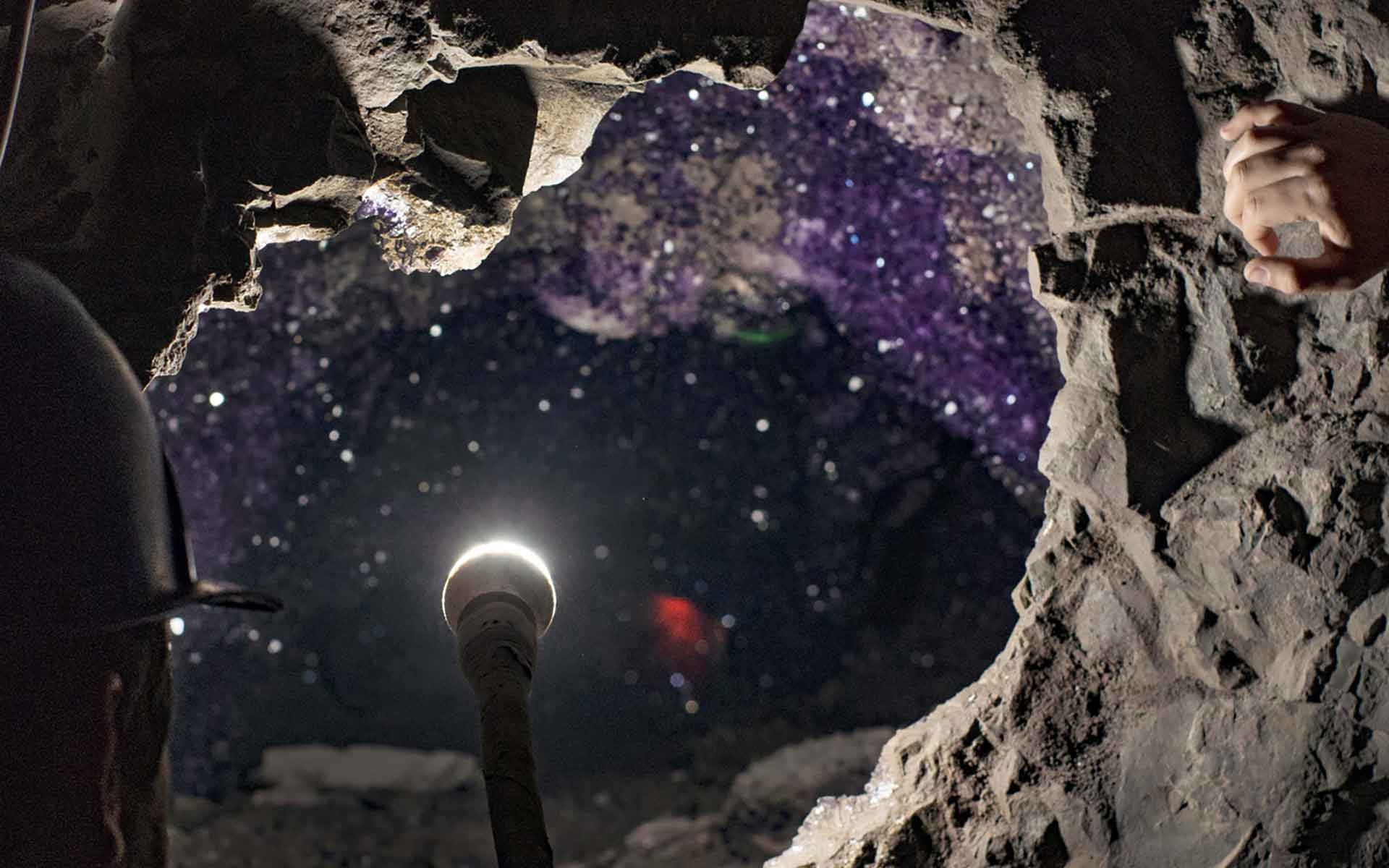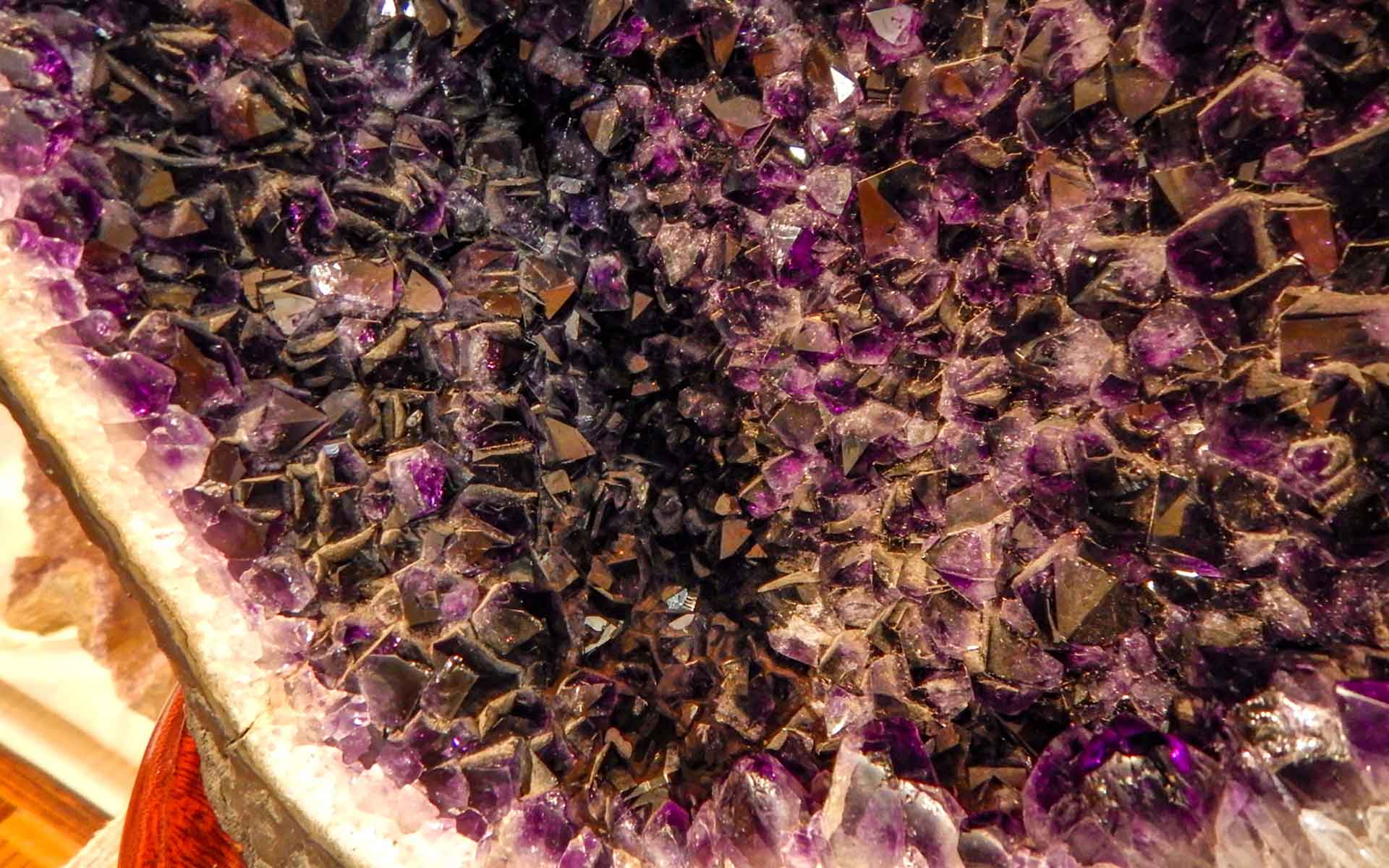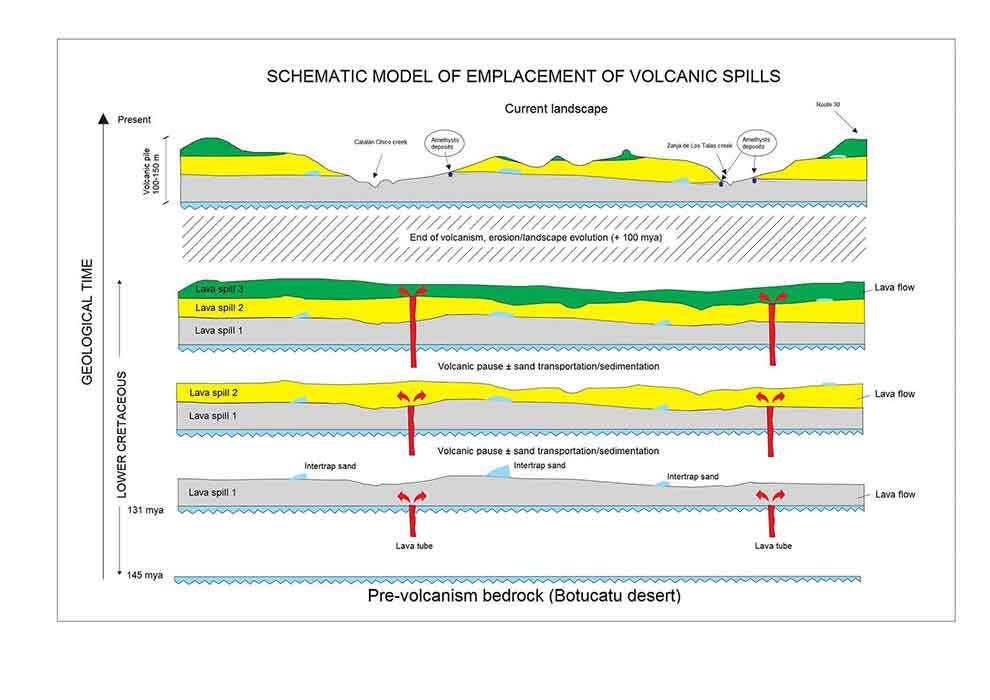
Amethyst-filled giant geodes discovered in an underground mine in Los Catalanes Gemological District. Shiny crystals of amethyst, in contrast to the opaque basalt that surrounds them, create an arrangement reminiscent of a starry night. (Photo: Santiago Guerrero).
Geological Period
Early Cretaceous
Main geological interest
Mineralogy
Location
Artigas Department, northern Uruguay.
30°47’34.0″S, 56°16’13.0″W
Amethyst-filled giant geodes discovered in an underground mine in Los Catalanes Gemological District. Shiny crystals of amethyst, in contrast to the opaque basalt that surrounds them, create an arrangement reminiscent of a starry night. (Photo: Santiago Guerrero).
The site of world-class amethyst deposits, where the largest amethyst-filled giant geodes were ever found.
Amethyst deposits in Uruguay are unique due to the concentration of mega-geodes, their enormous reserves, their gemstone quality and variations in size and forms, and by the abundance of giant geodes. Although amethysts occur in very different geological environments, the most important amethyst mineralization and mining are located in the areas of southern Brazil and northern Uruguay. Although geodic cavities filled with quartz are abundance in the Paraná basalt, the best amethyst deposits are in the lower-middle basin of the Catalan Grande stream. Achieving a understanding of the genesis of this mineralization and the origin of its intense purple color have motivated national and international investigations.
- Geological description
The amethyst-filled geodic cavities are housed in the Paraná flood basalt that comprises the large igneous province of Paraná-Etendeka traps. With an area of 1.5 million square kilometers and a volume of more than 2 million cubic kilometers, it is one of the largest igneous provinces in the world. The effusive magmatic event was associated with the break up of the supercontinent Gondwana and the opening of the South Atlantic Ocean during the Early Cretaceous (138-128 Mya). The extrusion of lava through multiple fissures occured in pulses (more than 25), which formed a volcanic pile more than 1 km thick. The basalt is composed of a succession of tabular bodies called spills or lava flows. Three different types of spills were identified: pahoehoe, aa and massive lava flows. The cylindrical, prolate geodes in pahoehoe lavas are up to 4 m tall, whereas the more irregular-shaped, oblate geodes in aa lavas are up to 5 m wide and weigh up to 20 tons. The understanding of the processes related to the generation of the geodes in the volcanic rocks of the large continental Paraná volcanic province is a major issue in volcanic and ore deposit geology.
- Scientific research and tradition
Amethyst deposits along the Catalan stream have been known since 1750, during the period of the Spanish rule. Numerous scientific works have been carried out on the site in the last two decades. In 2007, the Geological Survey of Uruguay published the first detailed study in the area, defining The Catalanes Gemological District. This is a region with a mining tradition of more than a century. Currently, several mining companies employing hundreds of workers are producing very high quality amethysts, and some abandoned mines support a geotouristic entrepreneurship.
- Reference
Duarte, L.C. et al. (2011) ‘Stable isotope and mineralogical investigation of the genesis of amethyst geodes in the Los Catalanes gemological district, Uruguay, southernmost Paraná volcanic province’, Mineralium Deposita, 46(3), pp. 239–255. Available at: https://doi.org/10.1007/s00126-010-0323-6.
Hartmann, L.A. (2008) Amethyst geodes formed from hot water in dinosaur times. Gráfica da UFRGS.
Morteani, G. et al. (2010) ‘The genesis of the amethyst geodes at Artigas (Uruguay) and the paleohydrology of the Guaraní aquifer: structural, geochemical, oxygen, carbon, strontium isotope and fluid inclusion study’, International Journal of Earth Sciences, 99(4), pp. 927–947. Available at: https://doi.org/10.1007/s00531-009-0439-z.
Techera, J. (2011) Exploración detallada de los yacimientos de amatista en el Distrito Gemológico Los Catalanes. Proyecto Ágatas y Amatistas – Fase II. Montevideo, Uruguay: DINAMIGE, División Geología.
Techera, J., Loureiro, J. and Spoturno, J. (2007) Estudio geológico, yacimentológico y minero de las piedras semi-preciosas del norte uruguayo. Proyecto Ágatas y Amatistas – Fase I. Montevideo, Uruguay: DINAMIGE, División Geología.
Waichel, B.L. et al. (2010) ‘Morfologia e estruturas dos derrames da Formação Arapey’, in Actas VI Congreso Uruguayo de Geología, pp. 456–461. Available at: https://www.sociedadgeologiauy.org/actas-de-congresos/.
- Author(s)
César Goso Aguilar
Geologist, Professor of Geology at the Geological Sciences Institute of the Faculty of Sciences (University of the Republic, Uruguay)
Mauricio Faraone
Geologist, Adviser of the Geological Survey of Uruguay National Directorate of Mining and Geology (Ministry of Industry Energy and Mining, Uruguay)


